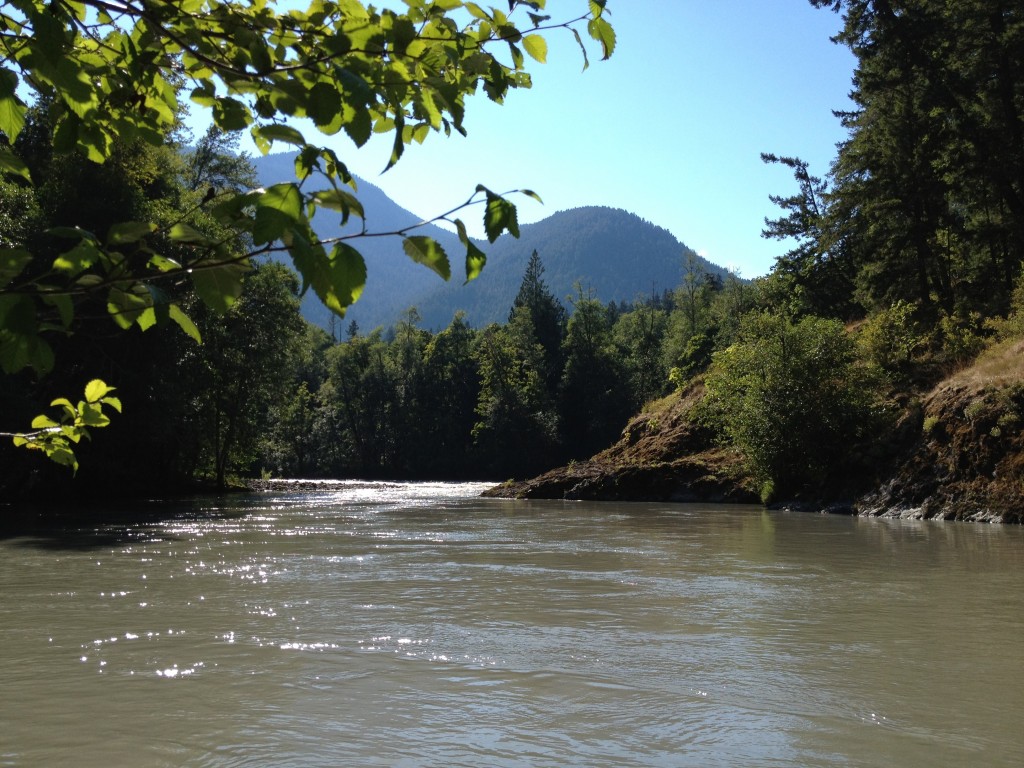
The water of the Elwha River flows beneath my raft, opaque with sediment. Upstream just a mile, the concrete Glines Canyon Dam is being demolished after 87 years of existence. Downstream, the river winds freely for twelve miles to the Pacific Ocean.
While the front of my raft absorbs the brunt of the rapids, I enjoy the quieter ride at the back, soaking in sensations from all sides. There is much at which to marvel: Olympic National Park, in western Washington, hosts an incredible array of biodiversity in its nearly one million acres. Above me spreads dense temperate rain forest; looming beyond the canopy stand Mount Olympus, Hurricane Ridge, and myriad unnamed peaks.
But I am not here for the grandeur. Rather, I’m interested in the tiny wonders of the river beneath me, where, in the flowing water, live the organisms that will feed a food chain that has been interrupted for the last 87 years. Monumental changes are taking place in the river, and they begin with small particles of silt.
***
The Elwha flows 45 miles from its snowfield source through the Lower Elwha Indian Reservation, finally emptying into an estuary at the Strait of Juan de Fuca, just west of Port Angeles. It drains an area of 270 square miles, most of it lowland old growth forest. For nearly a century, its path was interrupted by two hydroelectric dams, the Elwha and Glines Canyon Dams, built in the early 20th century by Olympic Power Company to provide energy to the city of Port Angeles. At 4.9 and 13 miles upriver from the ocean, respectively, they disrupted the river’s physical processes, creating reservoirs and starving the coastline of sand and sediment. Today, the dams are practically useless: the region’s electricity demand is of much higher in 2012 than it once was, and the dams are now capable of powering only 40 percent of a single paper mill. In light of their near obsolescence, both dams are being taken down in a colossal effort to restore the Elwha River salmon runs and the ecosystems that depend on them.
Dam removal nationwide has been considered a legitimate option for river restoration since the early 1990s. In 1992, legislation passed to remove the dams on the Elwha, and demolition finally began a year ago, in September 2011. By the following spring, the Elwha Dam was completely gone, and as of late September, only 76 feet of the Glines Canyon Dam – about a third of its starting height – remain.
The Elwha dams’ removal is the largest such project in American history, and is being studied and managed through the collaborative efforts of a diverse group of organizations, including the Lower Elwha Klallam Tribe, Olympic National Park, several local universities, the National Oceanic and Atmospheric Association, the National Park Service, the U.S. Geological Survey, and the Bureau of Reclamation. The project draws the interest of scientists and policymakers worldwide, as they observe the viability of large-scale dam removal for ecosystem restoration around the world. These waters I glide through in my raft have international significance.
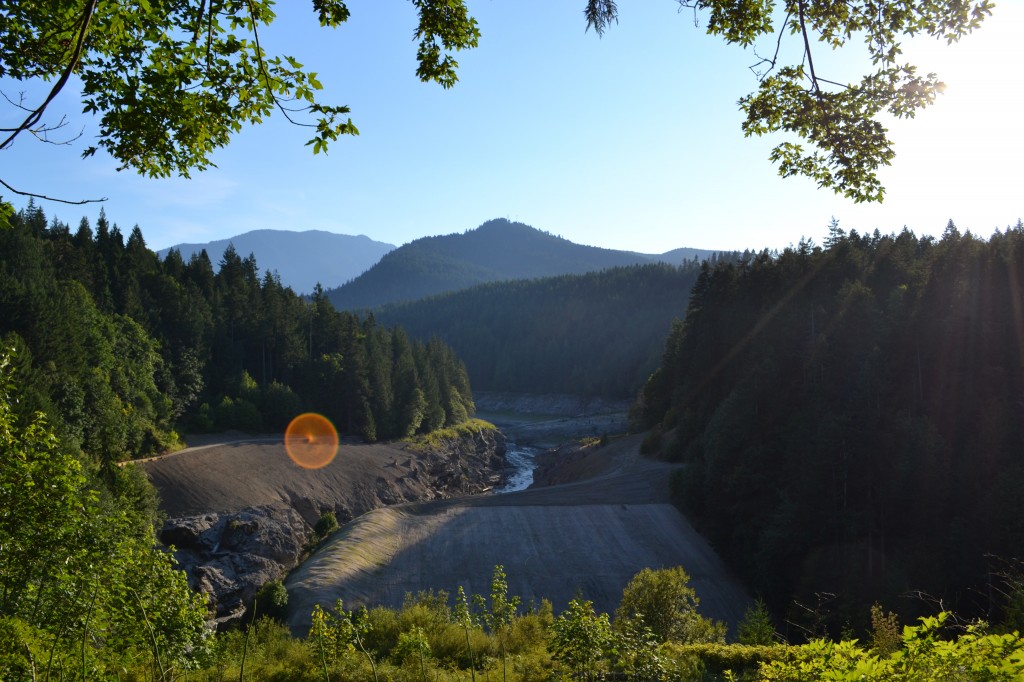
At the Glines Canyon site, a mile or so upstream, a very deliberate process is taking place. The concrete dam, originally 210 feet tall, has been slowly lowered by a series of controlled blasts. After each explosion, slightly more water is released from the reservoir to join the flow of the river. The system, called “notching,” keeps the water moving, but not too quickly. If the dams were to come down all at once, the huge release of water would bring with it an even greater danger: a huge release of sediment.
Scientists who study the Elwha have long been wary of the effects of sediment during dam removal. For the century that the dams were in place, the Elwha carried and deposited its load of sediment, derived from natural forces of erosion, behind the dams. The amount and variety of rocky material that collected in the reservoirs is astonishing. From silt to sand to gravel to boulders, 18 million cubic yards have been trapped within the reservoirs, 72 percent of it behind the Glines Canyon Dam alone.
As the dams are destroyed, and flow returns to the formerly stagnant reservoirs, up to a third of the coarse sediment, and about half of the trapped fine sediment, will be carried downstream. This release will greatly increase turbidity, a measure of the river’s cloudiness. If turbidity is too high, this sediment could choke the organisms that call the Elwha home.
Unfortunately, the river I raft down is a discouraging beige, and I can’t peer beneath the surface. If we’re lucky, the sediment could distribute in a way that creates habitat for salmon to lay their eggs and for benthic organisms to contribute to the food chain. At worst, it could hinder life in the river.
***
Sediment flowing downstream from headwaters to ocean is crucial to ecosystem health, but so too are the chemical nutrients carried upstream. On the Elwha, chemical properties are linked to the river’s physical parameters. Since the end of the last ice age about 15,000 years ago, the river has been fed by the glaciers in Olympic National Park: yearly snowmelt fills the park’s rivers. But these rivers are nutrient-poor for their size, because, coming as they do from pure snowmelt, they lack organic material.
So what nourishes the Elwha? The river actually relies on nutrients from the ocean for its ecosystem health. In many river systems like the Elwha, phosphorus is carried upstream from the ocean in the bodies of migrating fish, whose waste, death, and decay feeds into the nutrient flow. On the Elwha, the physical blockades of the dams have long prevented the transport of fish, and thus starved the river of nutrients.
Now that the barriers have been removed and the nutrients are again flowing, life is taking hold on newly exposed landscapes. Some four miles downstream from my raft lies the area that was, until recently, Lake Aldwell, the reservoir that had formed behind the Elwha Dam. Since the dam’s demolition, Lake Aldwell has drained completely, and exciting changes to the Elwha are apparent. Gray gravel fills a dried-up riverbed. Lines of sediment along both sides show former water levels; now, says Brittany Wilmot, a ranger at the National Parks Service, these dry banks are eroding regularly, creating an ever-changing landscape. The grayscale is stark against the intense green of the banks and Olympic Mountain foothills. Visitors may misinterpret the gray landscape as lifeless, but it is, in fact, life’s blank canvas.
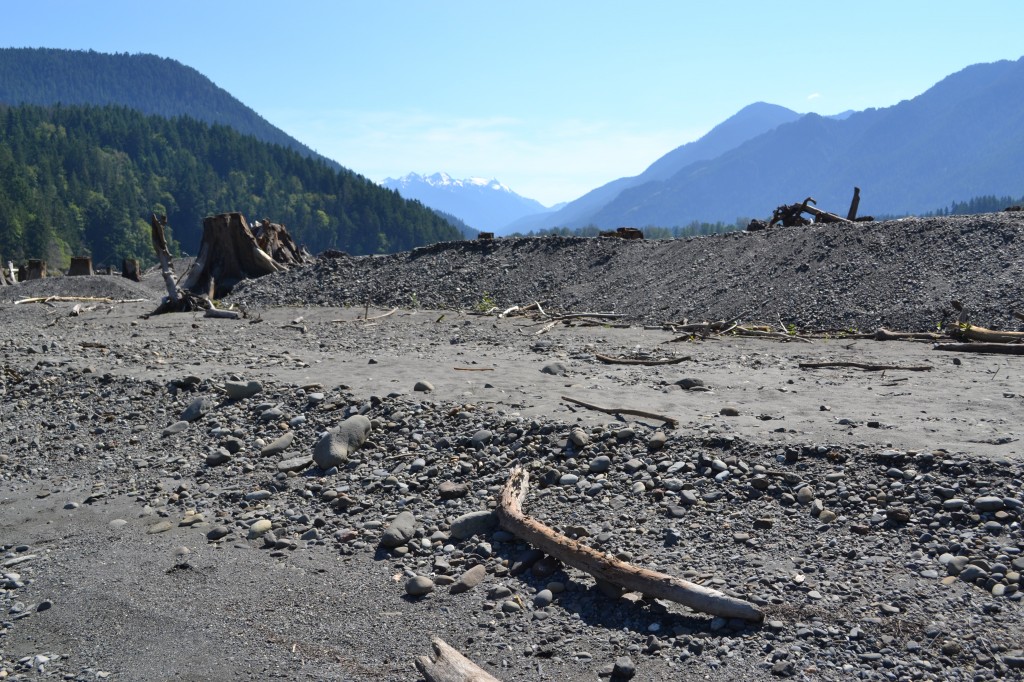
Here, ecosystem restoration is starting from the ground up. As river flow, sediment, and nutrient supply become reestablished, the stage sets for the human reintroduction of plants, which in turn lays the groundwork for the return of other species. The barren area at the old lake is large, and policymakers aim for a rapid return to greenery, with a goal of 70 percent revegetation in the next seven years. This is not a simple process. Plants are closely analyzed for their suitability to the Elwha banks. Huge volunteer efforts are required to grow the thousands of species being tested in a greenhouse in nearby Sequim and still more volunteers must introduce the plants to the exposed banks of the former Lake Aldwell. The plants are deliberately introduced in small plots to find those species that can best flourish with the changed soil and groundwater level — Douglas fir, for example, a beloved local species, is struggling to grow. Like many aspects of ecosystem restoration, plant reintroduction takes patience and causes frustration. It will be a few seasons before scientists know which species will be part of the Elwha’s future.
One of scientists’ main fears is that invasive species, such as reed canary grass, will capture the unclaimed area and starve out native species. Hosts of vegetation experts constantly watch and weed the riverbanks. And their efforts are paying off: naturally occurring native plants comprise some of the earliest visible changes along the shore. As alders that once bordered the lake die off for lack of water, new patches of greenery spread across the gravel — cottonwood, willows, fringed willowherb, aster. Ranger Wilmot marveled at the growth as we walked around the site: “Revegetation has started up on its own.”
Vegetation is not only found on the banks: the river itself is inhabited by a far smaller suite of photosynthesizing creatures. Benthic algae, attached to underwater surfaces such as rocks, already live in the Elwha, feeding on the scarce nutrients that the river supplies and providing much-needed oxygen to the system. Algae, along with floating aquatic plants, form a complex assemblage of life called periphyton. Each species of periphyton tolerates specific nutrients, so the abundance of a particular species can tell scientists a lot about the river’s condition.
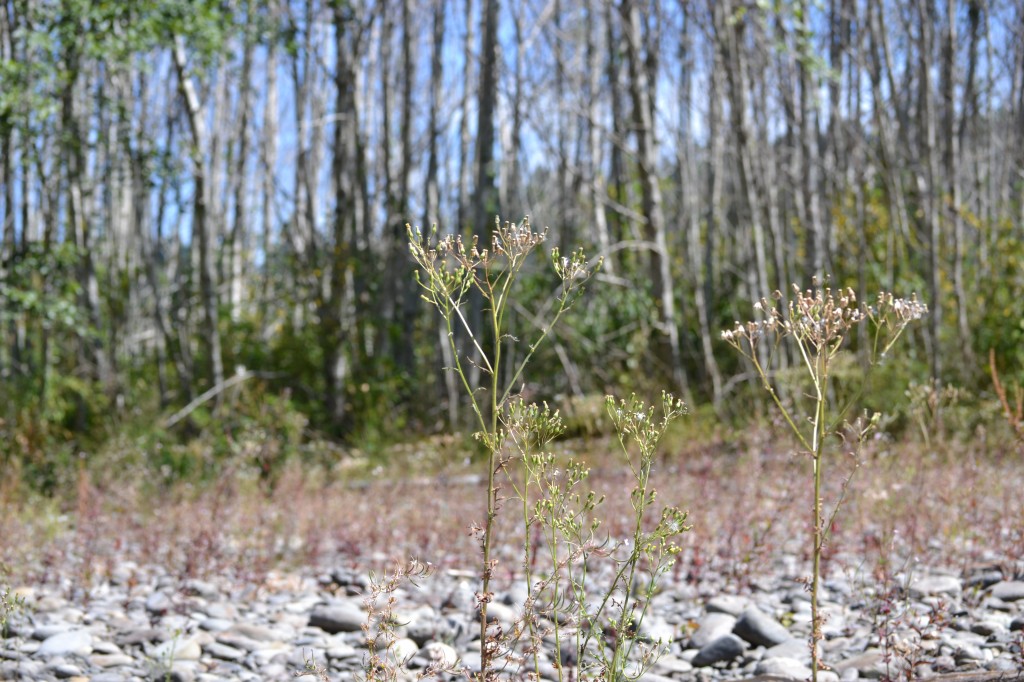
Periphyton are highly sensitive to turbidity: they can’t photosynthesize if too many particles block the sunlight. Many periphyton are expected to perish in the huge release of sediment that has followed the dam removal. But when sediment settles and salmon return, the algae’s population abundance and diversity are expected to reach a new equilibrium. Because their population is so large, and their response to nutrients so quick, periphyton are the heralds for the chemical and physical changes that are taking place in the river ecosystem. They provide a window into the murky water beneath my raft, demonstrating how the ecosystem is responding to dam removal.
A step up in the food chain, benthic invertebrates consume the periphyton. Deep in the Elwha, near the river bottom, dwell creatures such as worms, black flies, and mayflies. And, like the periphyton, these aquatic invertebrates signal the state of the river. Divers for the U.S. Geological Survey have spent years collecting samples of invertebrates and periphyton throughout the Elwha River Basin, providing baseline data for studies following dam removal. In 2006, for example, before dam removal, organisms of the order Diptera, which includes black flies, were more abundant below the dams than above by about 20.8 percent, thanks perhaps to the greater nutrient supply near the sea. Scientists aren’t sure what the dam removal will mean for benthic invertebrates, but they have their hypotheses. An increase in the abundance of Diptera in the Upper Elwha, for example, might reflect higher nutrient levels following river restoration.
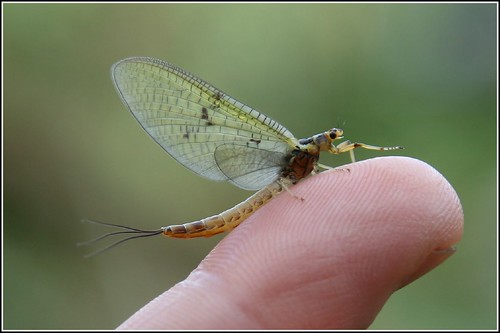
Scientists also have a close eye on mayflies above the old dam sites. They’re looking most closely for a decrease in mayfly populations, a development that could signal a momentous occurrence: the return of mayflies’ natural predators, salmon.
Salmon are the stars of the Elwha dam removal story. For thousands of years, the river provided a 70-mile run for chinook, coho, pink, chum, and sockeye salmon, as well as steelhead trout. In Olympic National Park, before the Elwha was dammed, young salmon born in the river’s upper reaches would make their way downstream to the Pacific Ocean to spend their adulthood, eventually returning to the freshwater tributaries of their youth to spawn, die, and feed the flow of nutrients. Or at least that’s what they did until 1910, when the Elwha Dam severed the fish from their runs. Though a Washington State law at the time required dams to allow fish passage, the dam’s constructor, Thomas Aldwell of the Olympic Power Company, managed to sidestep the law, offering to construct a fish hatchery as appeasement (and then failing to follow through on even this provision. When Glines Canyon dam was built upstream in 1925, there were no longer any salmon to provide passage for.
Since then, salmon populations on the river have been confined to the 4.9 miles below the dams. It’s bad enough that the salmon have been restricted from their 40-mile run, but the dam causes other problems, too: it increased water temperatures below the dam, resulting in high levels of disease and parasites; and it trapped the gravel upon which salmon rely to lay their eggs, depriving downstream salmon of vital spawning habitat. Before the dam, the river sheltered roughly 380,000 salmon; by the 1990s, the population was down to about 3,000.
The huge population decline severely affected salmon populations in the Pacific. In fact, it was the decline of salmon in the Strait of Juan de Fuca, that led the Federal Energy Regulatory Commission to conclude in 1991 that dam removal was necessary to restore these fisheries.
To protect salmon during the dam deconstruction, scientists must take painstaking precautions. The huge quantity of gravel released by dam removal could jeopardize lives and spawning patterns. Salmon, even those in the bottom 4.9 miles of the river, are especially sensitive to floating sediment while they migrate. For that reason, the demolition team provides “fish windows,” periods of salmon migration both up- and downstream, during which construction is halted completely.
It was during the August fish window that I rafted the Elwha. The water was still murky with sand, gravel, and larger rocks released by earlier demolition. While there wasn’t enough sediment to harm fish below the Elwha Dam site, salmon still can’t spawn all the way upstream. This sediment will not always be dangerous, though. If all goes well, the released material will slowly rebuild the fish’s future habitat.
The problem is that all might not go well if the system is left to its own devices. Scientists aren’t yet sure how the salmon will ultimately respond to the removal, so they have decided to supplement the fish population through hatcheries and artificial propagation. During the Elwha removal, to protect fish from the physical upheaval in the river, salmon at the dam sites were collected at different life stages — eggs, fry, presmolts, and smolts — and planted in hatchery stations. Hatchery scientists must study the length of each life stage, along with survival rates, for each species of salmon. Through these data, they can focus their efforts on those fish that are most vulnerable, and thereby release into the wild the smallest amount of hatchery-raised salmon possible. After the dams are both removed, eggs, fry, new smolts, and yearling smolts will be placed in the headwaters. The smolts will make their way to the ocean and, when mature, ideally — and naturally — return to the Elwha where they were placed.
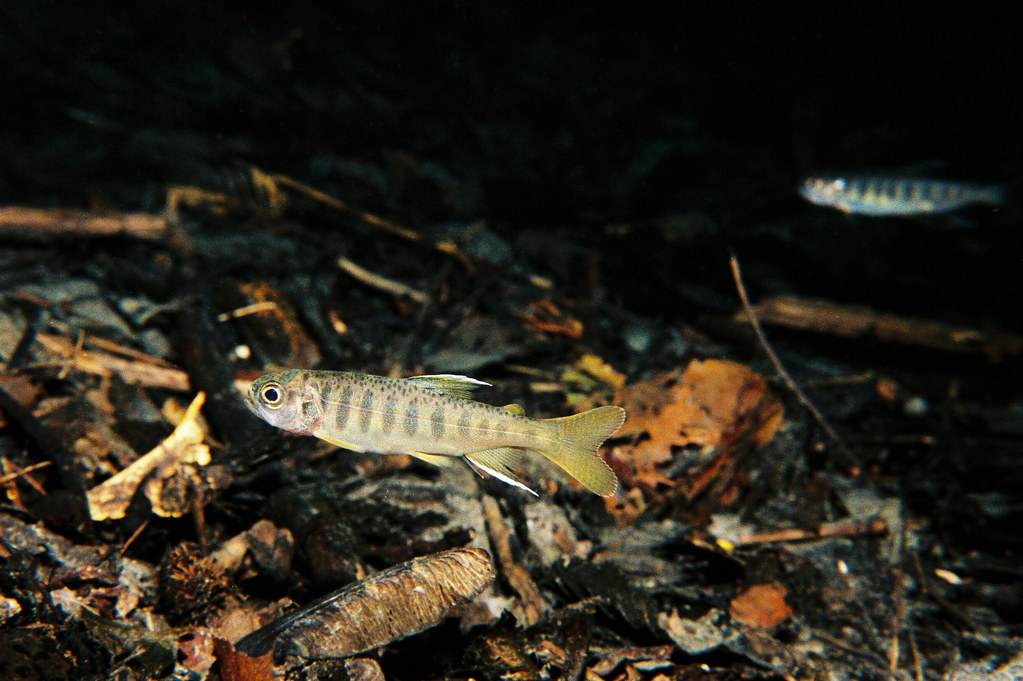
For the remaining year, as construction on Glines Canyon wraps up, a weir serves to protect the river’s fish. This barrier allows various agencies to monitor fish that migrate past the former Elwha Dam, and to transport those species threatened by sediment to the Little River rearing channel. Once the dam is fully removed, however, the fish will have to rely on their own instincts to return to the upper Elwha. The most crucial aspect of the restoration project, then, the one that will make recovery sustainable and absolute, is this: that salmon make their way, without help, to the Elwha headwaters to spawn.
And, by the end of August, they were doing just that. At the weir, scientists with the Washington State Department of Fish and Wildlife observed, incredibly, bull trout, steelhead trout, and chinook, pink, and sockeye salmon, all swimming upstream to spawn. At least preliminarily, restoration appears to be working.
But we must remember that these fish are not returning to the same environment that existed a century ago. Physical, chemical, and biological changes to the river have been extensive: the formation and drainage of reservoirs, the collection and release of sediment, the growth and death of trees around Lake Aldwell, the slow regeneration of new vegetation. Inside the river, lost nutrients will be replenished as algae and invertebrate populations thrive, crash, and thrive again. The changes that the river and fish runs have experienced from a century of damming cannot be erased. Our best hope is that the river emerges as a renewed ecosystem, distinct from its predecessor but equally successful. The salmon will be the judges of that.
***
My raft is now far downstream, nearly to where the old Aldwell reservoir marks the site of the former Elwha Dam. On the riverbanks, riparian life abounds, and every species I see will be affected as the salmon return. Primary producers, the alders along the water and the Sitka spruces behind them, shining with moss, will soon have fish bodies to use as fertilizer. The turkey vultures now catching drafts in small circles above the branches will feed on washed-up carcasses. Black bears that currently eat young bark, berries, and insects will supplement their diet with spawning salmon once again. Within the Elwha, decomposing bodies will supply nutrients to algae on the bottom of the riverbed, which will be gobbled up by invertebrates — the very insects that become prey for the migrating salmon. The loop will be restored.
For now, the water of the Elwha is opaque, the landscape-level changes still months or years away as humans attempt to reengineer a river. Someday, however, if the restoration succeeds, our role in the Elwha ecosystem will eventually fade. Someday, we will.be able to step back and simply transcribe the story that the river is writing.